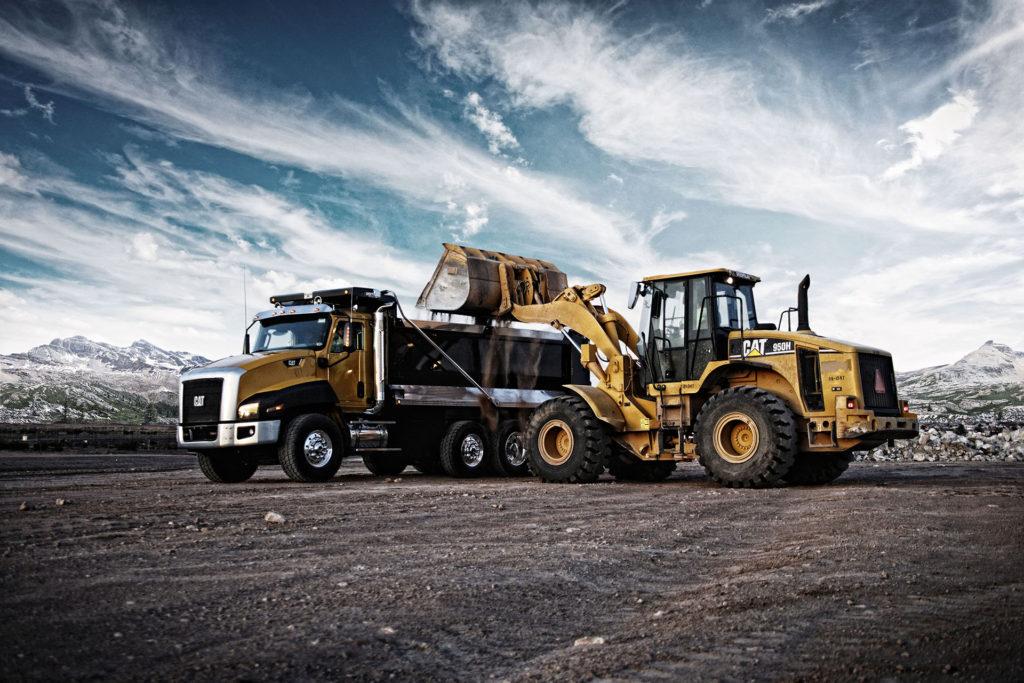
Heavy construction machinery
Construction equipment is a group of devices used in construction work. You can read about how the technology of these machines has developed in the article below.
3000 rpne – VI vpne The first type of crane was ancient crane (1) the so-called shaduf, which was originally used to raise water for irrigation. It was invented in Mesopotamia. The shaduf then appeared in ancient Egyptian technique around 2000 BC. Crane for lifting heavy loads it was developed by the ancient Greeks. Archaeological evidence shows that no later than about 515 BC. characteristic notches begin to appear on the stone blocks of Greek temples.
1. Drawing of an ancient crane
XNUMXth century BC The Roman engineer Vitruvius, in his treatise On Architecture, described heavy machinery and its purpose in Ancient Rome. Some of the devices he describes are similar to modern faucets (2). These cranes were usually of wooden construction and often used support wheels for the drive. The Romans also created other types of construction techniques, for example. copra-like designswhich were often used, as they are today, for building bridges.
2. A drawing showing Roman cranes
XV-XVI centuries Giovanni Fontana in the XNUMXth century, he constructed a device functionally reminiscent of the later single bucket excavator. A pointed chute was driven into the ground, and the prey was brought to the surface. In subsequent years, Leonardo da Vinci created many designs of mills, machines and engines driven by water. In addition, he created plans and models of how to use levers and hoists to make work on the construction site easier.
1475 The first headframes close to the modern design date back to the XNUMXth century. The technical drawing of the copra appeared in Francesco di Giorgio Martini's treatise "Trattato di Architectura". However, the first real construction machines of this kind were first used at the beginning of the XNUMXth century.
1796-1839 There are historical records of one Grimshaw of Boulton & Watt who developed the first steam shovel in 1796. In 1833, William Brunton patented another. steam powered excavator, the technical details of which were presented in 1836. A mature steam shovel design was developed by William Otis (3), who received a patent for his design in 1839.
The first machines of this type were called "semi-rotary" because the boom then could not rotate 360 degrees. They were built on a rail chassis on which the boiler and drive motors were mounted. The wheel drive was transmitted to the axles through a chain drive. In places where the excavator was supposed to work, workers built temporary railway tracks, which were moved if necessary.
Steam excavators became more popular in the second half of the 70th century. They were originally equipped with chain winches, but the introduction of steel cable in the 360s made it easier to attach to winches. Later, the machines were fitted with tracks, eliminating the need for rails. The 1884° rotating excavator was developed in England in XNUMX.
3. Otis excavator, 1841
4. Józef Maria Hoene-Wronski
30-ies Polish philosopher, mathematician and inventor Józef Maria Höne-Wronski(4) develops the concept of a crawler drive. By replacing the wheels with full-strip or track tread, the large surface area distributes the weight of the vehicle on soft ground without breaking.
50-60s XNUMXth century Until about 1850, "steamroller" meant stationary steel plate rolling and bending machine for boilers and ships. Since then, the term has also meant a vehicle.
Early rink was demonstrated by Louis Lemoine in France in 1860 and in Great Britain in 1863 by William Clark and an associate of W. F. Bato. Aveling & Porter was the first to successfully commercialize this product and then became the largest manufacturer in the world.
In 1866 a prototype was made with 3 foot wide rollers mounted on the back of a standard 12 horsepower rated traction motor. The experimental machine was described by local newspapers as "the world's first steamroller" and caused a public outcry. In 1867, the steam road roller was patented, and the company began producing the first practical steam roller—the new machine's rollers were front-mounted, not rear-mounted, and weighed over 30 tons. The car was tested on Military Road in Chatham, Star Hill in Rochester and Hyde Park in London and was a huge success.
5. Armstrong Hydraulic Drive Diagrams
1852-82 William George Armstrong (5) building an excavator that used hydraulic systems instead of mechanical ones to transfer power to the working bodies. This car was steam powered and was used to build a shipyard.
approx. 1876 His company Armstrong's Hydraulic Works is building in Elswick, England, in collaboration with another company, a 120-ton scissor crane with a hydraulic cylinder to lift a load, powered by 900 psi of water pressure. Shears were used to transport 100-ton gun barrels to Italy.
The first excavator using hydraulic technology was built in 1882 by his next company, Sir WG Armstrong & Company, and was used in the construction of the docks at Hull. Water was used to operate the hydraulic functions. It was not a fully hydraulic machine, but a hybrid that used ropes to operate the bucket, with a hydraulic cylinder operating the multiplier wheel set.
1892 American inventor John Froelich built the first stable working tractor with an internal combustion engine, equipped with front and rear gearboxes.
1896 first truck (6). It was a horse-drawn cart equipped with an internal combustion engine developed by Gottlieb Daimler. The drive was transmitted to the rear axle by means of a transmission belt driving a transverse shaft, which was connected to the wheels by means of racks.
6. Daimler's first truck
1896-1910 The next important step in the evolution of modern construction technology was dump truck development. It is believed that they appeared at the end of the XNUMXth century. One of the first seems Thornycroft steam truck(7), developed in the mid-90s, equipped with a specially designed dumping mechanism. One of the first dump trucks was developed by Fruehauf Trailer Corporation, Galion Buggy Co. and Louth-Jurgens, circa 1910. Around the same time, other companies such as the Wood Hoist Co. introduced hydraulic versions.
7 Thornycroft Steam Engine
1897 The first fully hydraulic excavator, which used only four direct-acting steam cylinders without cables and chains, was Direct action excavator built by Kilgore Machine Company. It was made almost entirely of steel. All movements were dampened, which eliminated shock and damage during operation.
1901 The first commercial tracked vehicle was the Lombard Steam Log Hauler (8). After various technical experiments, the first commercially successful heavy tracked vehicles. Patented in 1901 by Alvin Orlando Lombard, the Lombard steam log tractor was a great success. Later, the designer created the first serial caterpillar tractor, which is the ancestor of modern caterpillar construction vehicles. This technology was also used during the First World War, when the first tanks were built.
8. Reconstruction of Lombard Steam Log Hauler
1920 First-graders were pulled by people and draft animals. In the era of the automotive industry, thank you traction motors, steam tractors, trucks and tractors, towed graders have grown in size and performance. The first self-propelled grader was produced by the Russell Grader Manufacturing Company. Following the purchase of the company in 1928, Caterpillar continued to integrate the tractor and grader into a single structure, replacing the tracks with wheels, which resulted in the creation of the first self-propelled grader with tires, the Caterpillar Auto Patrol, in 1931.
1923 Farmer James Cummings and cartoonist J. Earl McLeod create the design of the first bulldozer bulldozer (9) in the modern sense of the term. They developed a large, earth-pushing blade that could be attached to the front of a tractor. Tractorwhich they used was designed for plowing round fields. Their patent for a "tractor accessory" was approved in 1925.
However, in 1923, the LaPlant-Choate Mfg company built a caterpillar construction with a pushing blade. What. from Cedar Rapids, Iowa, for use on the Dixie Highway in Kentucky. The key features of the Bulldozer Bulldozer are a large front blade and a powerful motor that can push large amounts of material. There have been many variations and variations of this type of dozer machines, both on tracks and on wheels with tires.
9 James Cummings Bulldozer Replica
J. Earl McLeod
1929-38 The first documented paver was developed by Barber Greene Co. She designed a machine modeled on the concrete spreaders of the time that mixed and placed concrete in one process.
Invented in 1933 independent floating tablewhich, in combination with the rammer, ensured a uniform density and thickness of the material. Harry Barber applied for a patent for the "Machine and road-laying process" on April 10, 1936 and received it in 1938. Main features of a paver developed by Barber Greene Co. have been used on most pavers since then, although machine controls have been improved.
1949 Hans Liebherr develops the first mobile tower crane TK 10 (10), which proved to be easy to transport and fast to assemble. Such structures were needed for the construction of ever higher buildings.
1953 They grow up in the UK first models of JCB backhoe loaders. However, these were only prototypes. The world's first backhoe loader was introduced to the US market by JI Case in 1957. His Model 320 was the world's first mass-produced backhoe loader.
1954 Demag (now Komatsu) builds the first fully hydraulic 360° crawler excavator of the type we know today. Model Hydraulikbagger from 1954 it was equipped with a 3 hp 42-cylinder diesel engine. and developed a speed of 2,5 miles per hour, carrying about half a cubic meter of material. It was a compact, efficient, agile and productive machine suitable for small to medium construction projects.
Some types of construction equipment
According to their purpose, machines are distinguished:
- for earthworks: dredgers, bulldozers and excavators;
– excavators
– bucket loaders
- flat breakout machines
⋅ bulldozers
⋅ scrapers
⋅ graders
⋅ rippers
– soil compaction machines
⋅ fight
⋅ compactors
⋅ compactors
⋅ assassins
- for foundation works: pile driving winches, pile driving pile drivers;
- for the preparation of aggregate: washers, mills, crushers, screens;
- for the preparation of mortars and concrete mixtures: mixers, concrete mixers, concrete plants, machines for compacting concrete mass;
- for concrete works: pumps, vibrators;
- for finishing works: grinding, gunning machines, plastering machines, concrete cutters;
- for transport: cranes, loaders, conveyors, vehicles;
- for road works of a paving: rammers, skating rinks, asphalt pavers, soil stabilizers, asphalt concrete cutters;
- for the construction of railway pavements;
- hydromechanization and drainage equipment;
– dredgers
– pumps
– pipelines
- needle punch kits
– sets of holes for needles
– borehole filters
- drilling equipment
- drilling rigs
– water dispensers
- savniki
– pulp thickeners and outlet separators
- auxiliary equipment, power generators, slings.
